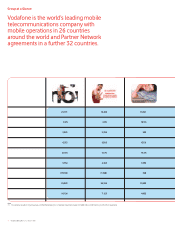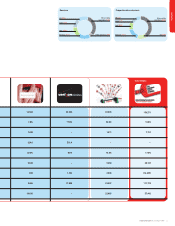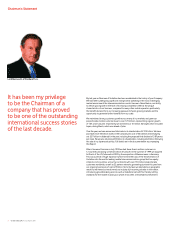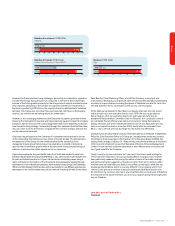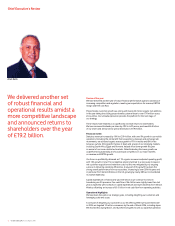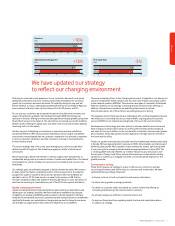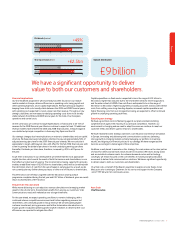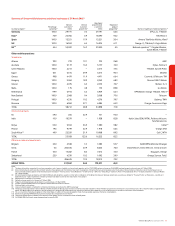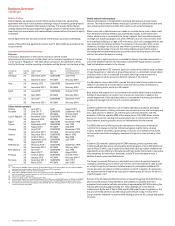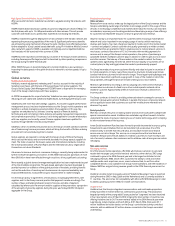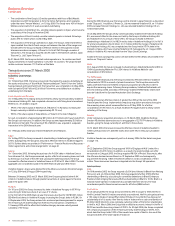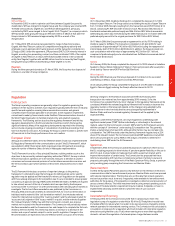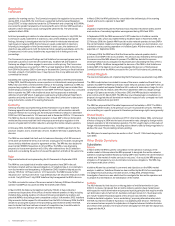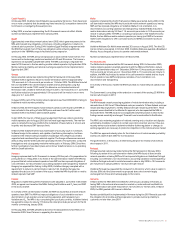Vodafone 2006 Annual Report Download - page 16
Download and view the complete annual report
Please find page 16 of the 2006 Vodafone annual report below. You can navigate through the pages in the report by either clicking on the pages listed below, or by using the keyword search tool below to find specific information within the annual report.
14 Vodafone Group Plc Annual Report 2006
Business Overview
continued
Partner Markets
Partner Markets are operations in which the Group has entered into a partnership
agreement with a local mobile operator, enabling a range of Vodafone’s global products
and services to be marketed in that operator’s territory. The Group’s Partner Market
strategy enables the Group to implement its global services in new territories, extend its
brand reach into new markets and create additional revenue without the need for equity
investment.
Similar agreements also exist with a number of the Group’s associated undertakings.
Details of the partnership agreements in place as at 31 March 2006 are provided on the
Group’s website.
Licences and network infrastructure
Licences
The Group is dependent on the licences it holds to operate mobile
telecommunications services. Further detail on the issue and regulation of licences
can be found in “Regulation”. The table below summarises the significant licences
held by the Group’s mobile operating subsidiaries and the Group’s joint venture in Italy:
Date of
Country by Licence Licence expiry Network commencement of
region type date type commercial service
Germany 2G December 2009 GSM/GPRS June 1992
3G December 2020 W-CDMA February 2004
Italy 2G January 2015 GSM/GPRS December 1995
3G December 2021 W-CDMA February 2004
Spain 2G July 2023(1) GSM/GPRS October 1995
3G April 2020 W-CDMA February 2004
UK 2G See note(2) GSM/GPRS December 1991
3G December 2021 W-CDMA February 2004
Other mobile operators
Albania 2G June 2016 GSM August 2001
Australia 2G June 2017(3) GSM/GPRS September 1993
3G October 2017 W-CDMA October 2005
Czech Republic 2G November 2020 GSM/GPRS March 2000
3G February 2025 W-CDMA See note(4)
Egypt 2G May 2013 GSM/GPRS November 1998
Greece 2G September 2012 GSM/GPRS July 1993
3G August 2021 W-CDMA July 2004
Hungary 2G July 2014(5) GSM/GPRS November 1999
3G December 2019 W-CDMA December 2005
Ireland 2G December 2014 GSM/GPRS March 1993
3G October 2022 W-CDMA May 2003
Malta 2G September 2010 GSM/GPRS July 1997
3G August 2020 W-CDMA −
Netherlands 2G February 2013(1) GSM/GPRS September 1995
3G December 2016 W-CDMA February 2004
New Zealand 2G See note(6) GSM/GPRS July 1993
3G March 2021(6) W-CDMA August 2005
Portugal 2G October 2006 GSM/GPRS October 1992
3G January 2016 W-CDMA February 2004(7)
Romania 2G December 2011 GSM/GPRS April 1997
3G March 2020 W-CDMA April 2005
Notes:
(1) Date relates to 1800MHz spectrum licence. Vodafone Netherlands and Vodafone Spain also have separate 900MHz
spectrum licences which expire in March 2010 and February 2020, respectively.
(2) Indefinite licence with a one year notice of revocation.
(3) Date refers to 900MHz spectrum licence. Various licences are held for 1800MHz licences, which are issued by specific
regional regulators. The earliest expires in June 2013 and the latest in March 2015.
(4) Planned for the 2007 financial year.
(5) There is an option to extend this licence for seven years.
(6) Vodafone New Zealand owns three GSM 900 licences (2x21MHz) and one GSM1800 licence (2x15MHz). The GSM900
licences expire in November 2011, July 2012 and September 2021. The GSM1800 licence expires in March 2021.
(7) Portugal launched the Vodafone Mobile Connect 3G/GPRS data card in February 2004, and the launch of 3G voice
services took place in May 2005.
Mobile network infrastructure
Network infrastructure is fundamental to the Group being able to provide mobile
services. The mobile network enables the Group’s customers to place and receive voice
calls and allows the Group to provide other services, such as text messaging.
When a voice call or data transmission is made on a mobile device, voice or data is sent
from the device and transmitted by low powered radio signals to the nearest base
station, which in turn is connected to the Group’s network. Each base station provides
coverage over a given geographic area, often referred to as a cell. Cells can be as small
as an individual building or as large as 20 miles across. Each cell is equipped with its own
radio transmitter and receiver antenna. This network of cells provides, within certain
limitations, coverage over the service area. When a customer using a mobile device
approaches the boundary of one cell, the mobile network senses that the signal is
becoming weak and automatically hands over the call to the transmission unit in the
next cell into which the device is moving.
If the voice call or data transmission is intended for delivery to another device which is
not on the Vodafone network, the information is delivered through a public or private
fixed line telephone network or the internet.
In a second generation (“2G”) network, each cell contains a base station using a number
of radio frequencies or channels. A group of base stations is connected to a base station
controller, which in turn is connected to a mobile switching centre and then via a
gateway support node for access to a fixed line network or the internet.
In a 3G network, voice or data traffic is passed through a node B, being similar to a base
station in a 2G network, to a radio network controller, which is then connected to a
mobile switching centre, similar to a 2G network.
Base stations and node Bs form a core element of a mobile network and an insufficient
number of base stations can result in loss of service for customers. In addition, the
correct deployment of the right base stations is instrumental in achieving the network
quality and coverage that are crucial to customer satisfaction.
2G
Vodafone operates 2G networks in all its mobile operating subsidiaries, principally
through GSM networks, offering customers services such as voice, text messaging and
basic data services. In addition, all of the Group’s controlled networks, with the
exception of Albania, operate GPRS, often referred to as 2.5G. GPRS allows mobile
devices to be used for sending and receiving data over an internet protocol (“IP”)
based network, enabling wireless access to data networks like the internet.
The GPRS data service offering includes internet and e-mail access allowing the
customer to be always connected at download speeds slightly below a dial-up
modem. Vodafone also offers a great variety of services on its Vodafone live! portal,
such as picture and video messaging, download of ringtones, news and many other
services.
3G
Vodafone’s 3G networks, operating the W-CDMA standard, provide customers with
mobile broadband data access, allowing data download speeds of up to 384 kilobits per
second (“kbps”), which is up to seven times faster than a dial-up modem. Vodafone has
expanded its service offering on 3G networks with high speed internet and e-mail access,
video telephony, full track music downloads, mobile TV and other data services in
addition to existing voice and data services.
The Group has secured 3G licences in all jurisdictions in which it operates through its
subsidiary undertakings and in which such licences have been awarded to date, as well
as in Italy through its joint venture. Vodafone expects to participate in additional 3G
licence allocation procedures in other jurisdictions in which it operates. No assurances
can be given that the Group will be successful in obtaining any 3G licences for which it
intends to apply or bid.
Roll out of the 3G network infrastructure has continued throughout the 2006 financial
year across the Group’s mobile operations, with additions to property, plant and
equipment and computer software amounting to approximately £4.0 billion during the
financial year, including approximately £1.1 billion expenditure on 3G network
infrastructure. By the end of March 2006, over 33,000 node B’s were in operation in the
Group’s controlled operations and the Group’s joint venture in Italy. In many of the
Group’s markets, Vodafone has achieved the leading position on 3G coverage and quality
of service.


